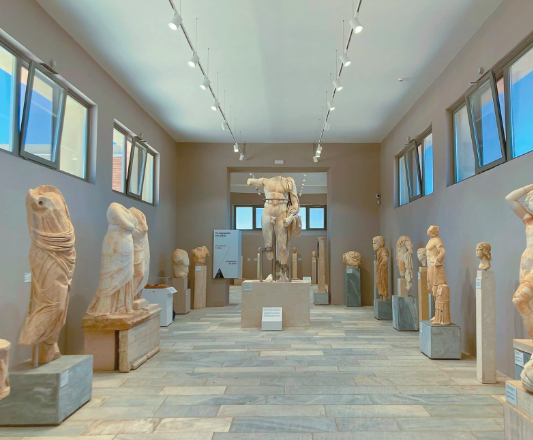Prohibited by Intellectual Property Law: Any illegal use or appropriation of this content in any form is prohibited, with severe civil and criminal penalties for the violator.
Delos, 1063 AD: An Arab known as Al Mandali, meaning the Mytilenean, arrives on the island’s ruins and leaves his name in a calligraphic inscription on a marble slab of the ancient sanctuary. This discovery during recent work on Delos shows that the island remained significant beyond antiquity, continuing to reveal treasures and serving as one of Greece’s and the world’s most important archaeological centers.
The Statue of Gaius: A wealthy merchant from Campania named Gaius Opellius Ferus arrived in Delos, sponsoring the construction of the famous western colonnade of the Italian Market. To ensure his memory endured, he had his statue built in a niche.
Last week, the renovated Delos Museum, which had been closed for essential work, was inaugurated along with an exhibition titled “Delos – Rineia – Mykonos: Images from 150 Years of Archaeological Research.” Organized by the Cyclades Ephorate of Antiquities in collaboration with the Municipality of Mykonos and the French School of Athens, it was attended by the President of the Republic, Katerina Sakellaropoulou.

In his speech, Dimitris Athanasoulis, the active head of the Cyclades Ephorate of Antiquities, highlighted this unique inscription on a marble slab of the ancient sanctuary. He emphasized the island’s strategic role throughout the centuries, serving as an anchorage in the heart of the Greek archipelago during the Middle Ages. Byzantine and Arab visitors, including Knights of St. John, roamed the ancient buildings that stood tall despite looting.
The Island of Light: Delos, the island of Leto and Apollo, remained a point of reference throughout history, inspiring endless narratives. The myth that this small island, around which the Cyclades danced, was the birthplace of two gods was not random; Aristotle’s geodetic law deemed it the ideal sacred site.

Delos attracted archaeologists from around the world at various historical moments. Even in the Middle Ages, the island was a reference point, being the subject of early mappings that guided archaeologists from the 18th century onwards, including Catherine the Great’s envoy, whose findings still adorn the Hermitage.
Aphrodite Statue: A statue of Aphrodite in the “Cnidian” style, where the goddess is depicted nude preparing for her bath, was particularly popular in Delos, as evidenced by numerous similar statues found.
Early Excavations: The island, sacred and untouchable by barbarians, where ancient Athenians stored their wealth and secrets, featured in various knight and traveler stories. The Delos-Mykonos Ephorate of Antiquities was founded in the late 19th century, beginning in collaboration with the French School, leading to extensive excavations.

Renovation and Future Plans: The recent museum renovation included modern infrastructure and enhanced its permanent exhibition. The “Delos – Open Museum” project aims to create new visitor routes and significant restoration works, transforming the archaeological site into a prominent cultural center.
Despite challenges, such as extreme weather conditions, the work continues with a completion target of April 1, 2025. An all-inclusive ticket will cover the archaeological sites. The ongoing scientific and archaeological efforts are crucial for preserving and showcasing Delos’s rich history.
Ask me anything
Explore related questions





